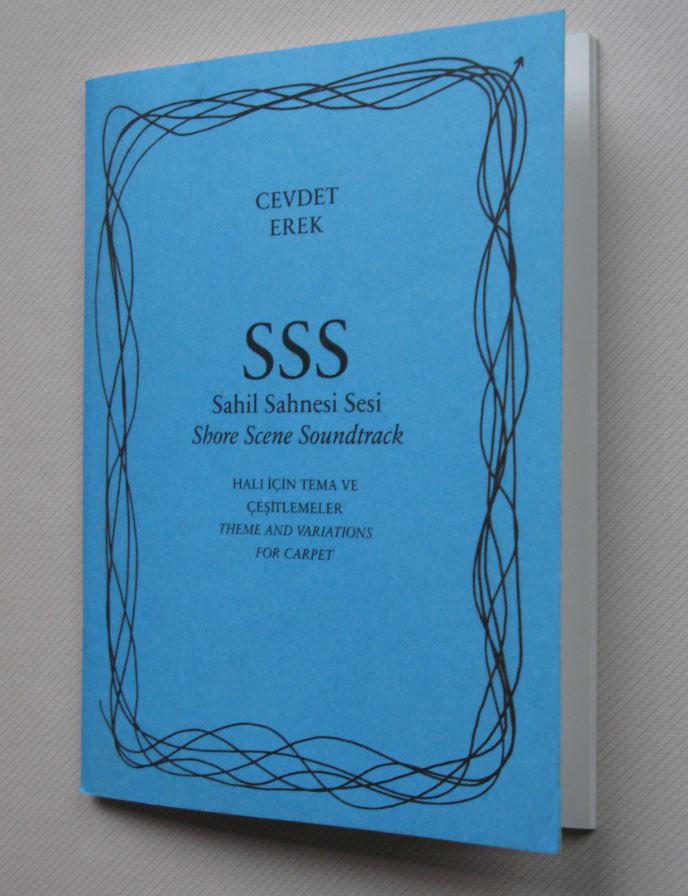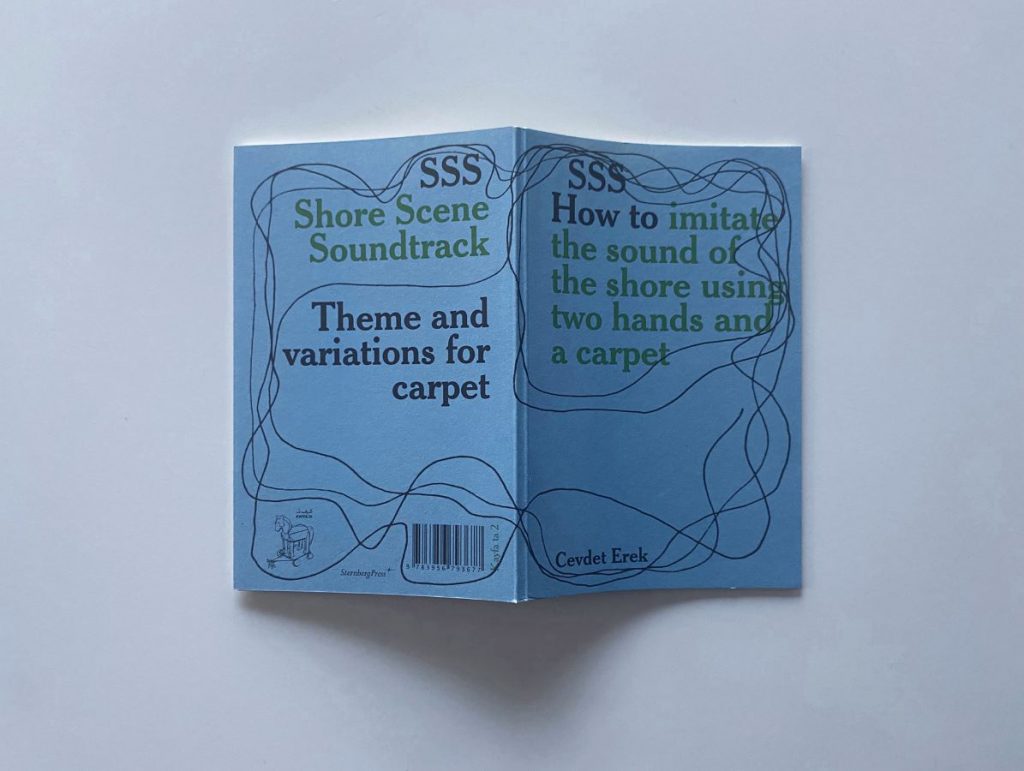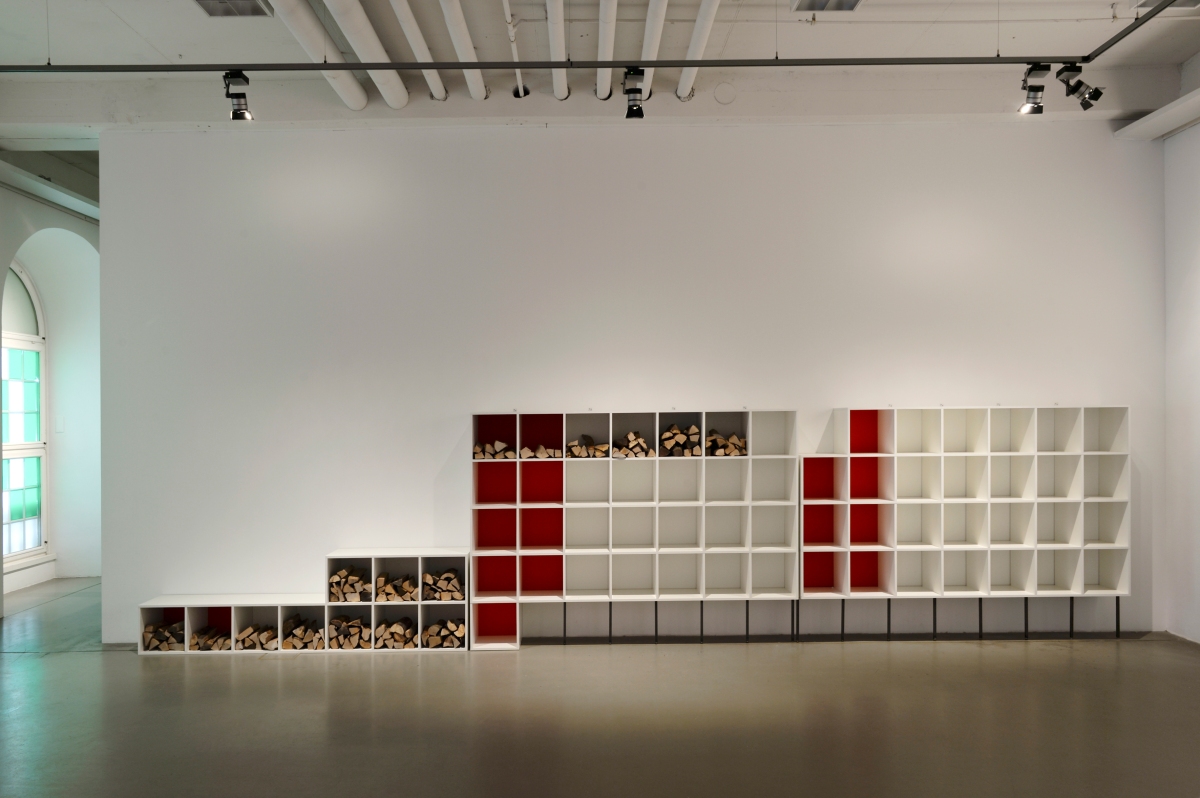Interview: Seniha Ünay / About
Translation: Burçin Nilay Kalınbayrak / About
The guest of the May issue of Narratives Interview Series is Cevdet Erek, an artist and musician whose artworks are involved in various national and international events, exhibitions, institutions and collections. During the interview, we conversed with Erek about the impact of his education on his art, his relation with music, and his view on the unity of architecture, history, and sound. We had the opportunity to read his production process through the strong relations he establishes with sound, typography, architecture, language, history and the audience.
“Architecture, history and sound are all together in life. By creating concentrated moments, spaces and forms, I try to present new ways of coming together within this unity.”

You graduated from Mimar Sinan Fine Arts University Department of Architecture. Then you studied Sound Engineering and Design at Istanbul Technical University Dr. Erol Üçer Center for Advanced Studies in Music (ITU MIAM) and you are a member of Nekropsi, an experimental rock band, since the early 1990s. In your works, you mostly reshape the space with sound and you almost turn the space into a stage for the audience. Could you tell us about how your educational and musical background shape your art and what their reflections are on your production and thought processes?
It is not easy to arrange or summarize the impact of education on art production, since I am currently at university and my education somewhat continues. Based on your question, it sounds good to talk about synchronizations that may not be entirely planned. In other words, about the coexistence of different -formal or informal- educations and practices, about an unwitting emergence by trial and error of a working method between multiple kinds of things… It seems that while I was studying Architecture at Mimar Sinan Fine Arts University, dealing with music, learning by practicing how to make, present, and publish it with my group friends, being a part of a live period, being a part of a crew afterward formed the initial infrastructure of the general view as a continuation of education and practice. Multicolored, fruitful processes involving the unfinishedness or as well as the imbalances of the coexistence of multidirectional works.
Cevdet Erek, “Bergama Stereo”, Hamburger Bahnhof, Berlin, Germany, 19.10.2019-08.03.2020. Photo by Matthias Voelzke.
“It can be said that rather than to be concluded, they are trying to provide even more physical and intellectual space to the audience, even though they are designed, very much detailed, and large scale works.”
Your works are in constant change perhaps because of their nature. They are particularly creating a physical, intellectual and sensory experience space for each viewer. For example, your work “ÇIN” at the 57th Venice Biennale in 2017, was changing with performative interventions during the biennial. Can we mention a structure that is always dynamic in itself, has a changing atmosphere and is inconclusive?
Yes, we can say that some of the works have dynamic and inconclusive structures in themselves. On the other hand, there are also rigid works that never change. Most of the works in the last decade aiming at creating spaces answer to your definition. It can be said that rather than to be concluded, they are trying to provide even more physical and intellectual space to the audience, even though they are designed, very much detailed, and large scale works. “ÇIN” has these characteristics as well, and I just want to add a note on how it is changing with performative interventions that you have just mentioned: For “ÇIN”, a set of space was prepared for these performative interventions, even for the performances that could take place at the same time, but the absence of those interventions or performances was centered on. An attempt was made to add the blocked and closed public spaces, which we were experiencing profoundly in our daily lives in those years, directly to the experience in the Turkey Pavilion in the exhibition space. Some of the audience had some expectations in the venue and had questions to the exhibition attendants like “When does the performance start? Is it over?” During my limited trips to Venice after the exhibition was opened, I often heard these kinds of questions and reactions when I was in the space under the guise of an exhibition attendant -not to deliver a performance, but to watch the audience and try to understand how this new mechanism works. The absence of performance prevailed during the entire exhibition except that the audience was playing with the architectural fragments of arches standing on the floor at the back of the space, making combinations of them, or putting on small spontaneous plays, and dancing.
Cevdet Erek, “ÇIN”, Sound Installation, Pavilion of Turkey, The 57th Venice Biennale, 13.05.2017-26.11.2017. Photo by RMStudio.
We would like to touch on your artist book “SSS Shore Scene Soundtrack” for which you received Nam June Paik Award in 2012 given by the Arts Foundation of North Rhine-Westphalia. You prepared a guide in SSS including methodological and theoretical knowledge to describe how to imitate the shore with procedures, formulas and visuals. You are asking “how to imitate the sound of the shore using two hands and a carpet.” You are like a teacher who asks questions to which we never know the answer but in the most fun way and who always surprises us. How do you feel the sound of an object (carpet)? Could you explain how you visualize the sound while shaping such an idea?

“Shore Scene Soundtrack” was first displayed as a performance, then a video consisting of a sound/image recording made in the studio, and then an installation with the addition of the carpet. Its transformation into a book came to light when dear Banu Cennetoğlu and Philippine Hoegen invited me to make a book at BAS within the scope of the BENT series. When I started working on the book, I focused on how to explain the experience that emerged from the performances I had done so far and accordingly the basic motivations of the work to another person who would perform as well. The book tries to visualize because of the nature of the printed material. But at the heart of the whole work, there is not the visualization of the sound, but the questions on how to touch an everyday object and its sound by focusing on it, how to imitate the sound of another place and situation with that sound and how to perform it by myself or for others. On the other hand, to expand your question about the visualization of the sound, I can draw attention to the objects, which can be perceived as monochrome at a distance or at first glance, especially when exhibiting one or more carpets on the walls of museums. They attempt to create tense relations between seeing-hearing/listening-touching after they are heard and “begun”, from the moment the viewer touches them.

Cevdet Erek, “SSS Shore Scene Soundtrack”, Artist Book, Sternberg Press, 2012.
“While I am talking about ideas turning into words, texts, and sounds in all these works, I should also add that the research for the forms that constitute the writing and their relations with the environment and architecture is at the center of the works.”
In your work “Chiçiçiçichiciçi”, displayed at the Art Institute of Chicago in 2019, there are syllables accompanying the metal bars which are also a reference to the name of the work. Your “AAAAA” exhibition in 2018 at M HKA, Museum of Contemporary Art in Antwerp, Belgium is based on the facades of buildings in Antwerp that resemble the letter A. In the “Winter Ausstellung” in 2016 at Kasseler Kunstverein, we see letters and syllables again. In your “Shading Monument for the Artist”, exhibited in many countries, you present a form based on the idea of creating a fringe with letters. Could you talk about the use of typography and the relation between language and sound in your works?
Let me try to make short descriptions to explain what is going on in these works in terms of language and sound you mentioned. It may give some insight into the view on this relation and the attempts.
In “Chiçiçichiciçi” there was a series of bars on a long wall against which we rub an object such as a stick or a pencil while walking or running. Depending on the type of the bar, the object in our hand, and the power, the sounds of takataka, tikitiki or çiçiçiçi were heard. While I and Tolga from the former Nekropsi group at the opening or the audience were doing that, similar sounds were transmitted through special speakers to some particular corners of the long “modern wing” section with many points of entrance and exit in the Art Institute of Chicago. When you turned from those particular corners towards the direction from where the sound comes, you saw the playing sound patterns transformed into inscriptions engraved on the wall, sometimes not being sure how to read it.
Cevdet Erek, “chiçiçiçichiciçi”, Sound Installation, Art Institute of Chicago, 28.02-21.04.2019. Photo by Cevdet Erek.
Right across the walls of M HKA Antwerp, there was “AAAAA” like a comic book sound effect. Letters of A which were slightly different from each other seemed like they were in a photograph or a place, a window opening to the outside when you are across it or the city itself while it is shouting at us… Of course, then a twist was occuring when we read the text or someone whispered it to us and when we realized that these large figures were one-to-one scaled representations of the facades of Antwerp’s narrow, duplex houses selected from some of its districts.
Cevdet Erek, “AAAAA”, Installation, M HKA Museum of Contemporary Art, Antwerp, Belgium, 20.01-29.04.2018. Photo by Christine Clinkx.
In “Winter Ausstellung”, the inscription WINTER to be read from right to left was nailed on the wall with the approximate amount of wood lighted in the house of the person in charge of the exhibition space. During the exhibition, a daily amount of wood was removed from the wall and placed in the calendar-shaped wood cabinet every day. Almost towards the day on which we celebrate the spring, the WINTER inscription on the wall was disappearing and returning to the storehouse. On the other hand, the days of the week were formed with the additions made to the 7 windows of the exhibition space, as we had tried a similar one before in Künstlerhaus Stuttgart.


Cevdet Erek, “Winter Ausstellung”, Kasseler Kunstverein, Kassel, Germany, 22.01-27.03.2016. Photo by Nils Klinger.
“Shading Monument for the Artist” is the oldest amongst the works you have mentioned. There is no direct emphasis on sound or measured/cyclical time here. At the end of the working period at Can Xalant Centre for the Creation and Contemporary Thought in Mataro on the coast of Barcelona, it was designed as a fringe to the building. The center closed under the rule of the new government and my work continued to be displayed in museums. Quotations from the inscriptions on the monuments made in commemoration of the international brigades in their hometowns who fought in the Spanish Civil War were reunited for art in a heroic text for those who left their homeland. This text turned into a fringe (there was no shade in Can Xalant’s garden under which to work in sunny areas), prepared a shade for the arriving art connoisseurs, and became readable at certain hours. First, the English versions and then the Spanish version for the Cuenca Biennial were made. At the Utrecht Centraal Museum, where it is exhibited permanently, we produced a small Dutch version alongside the original size, like a subtitle that can be displayed at almost eye level.
Of course, while I am talking about ideas turning into words, texts, and sounds in all these works, I should also add that the research for the forms that constitute the writing and their relations with the environment and architecture is at the center of the works. I think it is not necessary to highlight that it is also a matter of curiosity and joy.
Cevdet Erek, “Shading Monument for the Artist”, From the group exhibition “The Art of Climbing Mountains”, 303 Gallery, New York, 29.06-29.07.2011.
“History, periods, places, people, narratives, struggles”
Finally, we would like to bring up your work “Bergama Stereotip”, which we had the opportunity to see at Arter last year. It was a sound installation specific to Arter, and also the continuation of your work “Bergama Stereo” which was exhibited in Germany in 2019. Through sound, your work was addressing the history and architecture of the Pergamon Altar, which was built in the 2nd century BC in the ancient city of Pergamon, known as Bergama in İzmir, but was taken to Germany in the 1870s. Centering on this work, could you tell us about the unity of architecture, history and sound in your art production?
Architecture, history and sound are all together in life. By creating concentrated moments, spaces and forms, I try to present new ways of coming together within this unity. These relations are often defined by the “things” that I feel excited to concentrate on or deem necessary to deal with. Sometimes the events I have been invited to and the history and venues with which the institutions are associated are also included in these relations. I try to enrich these relations by receiving feedback and presenting other ways of seeing and hearing to other potential enthusiasts or viewers who suddenly find themselves in the exhibition space.
Cevdet Erek, “Bergama Stereo”, Hamburger Bahnhof, Berlin, Germany, 19.10.2019-08.03.2020. Photo by Matthias Voelzke.
“Bergama Stereo” was fed by history, periods, places, people, narratives, struggles associated with each other including why the Pergamon Altar was built, which is known to be built during the Kingdom of Pergamon in the city of Pergamon, the narrative of the Gigantomakhia Frieze surrounding the Altar, the construction story of the Altar, the assembly of its parts after it was taken to Berlin, the construction of the Pergamon Museum around the Altar with a very creative form of installation, Berlin between the two world wars and its resistance against fascism, what happened during the Soviet era, then again Bergama, the campaigns, then Berlin in the last two decades which I have experienced. Afterwards, the idea of how to bring it to Istanbul, to the context of Arter and how to reproduce it came to life with the title “Bergama Stereotip”. When it comes to the forms, there was an attempt again not to recreate the visual narrative with an audio arrangement that did not eliminate the architecture, but to make another proposal against it. The sounds were trying not to turn the visual narrative of the historical frieze into sound, but to come together with the architecture, to direct it and to take part from it by using its own means. Various percussions/percussive sounds, growlings and others were clashing against each other with the architecture that they surrounded and even set the dimensions, transmitting around, resounding through the walls and the exhibition space, returning and becoming a part of the sound mix. Then we imagined that the work was resounding with new ideas in the minds and bodies of the viewers who were sitting or wandering around, on, next to, across, and on the steps of the work.
Cevdet Erek, “Bergama Stereotip”, Sound Installation, Arter, İstanbul, 27.02.2020–30.12.2020. Photo by flufoto.
Our thanks are due to Cevdet Erek.
- For more information about Cevdet Erek, you may visit his website.
- Besides the photos and visual images by Güncel Sanat Arşivi, all the other photos in this interview are used from the website of the artist and courtesy of him.
- Portrait Photo: Cevdet Erek, “chiçiçiçichiciçi”, Opening Performance, Art Institute of Chicago, 28.02.2019. © Cevdet Erek
- The rights of all the visual and textual concepts in this interview are reserved. Quotation shall be allowed provided that the source shall be mentioned in the work where the quotation is cited. For the photos please contact the artist.
Please click for more information about Narratives Interview Series
